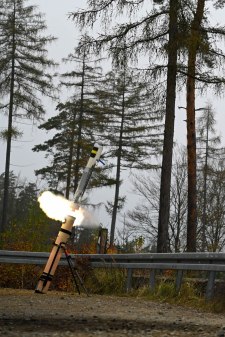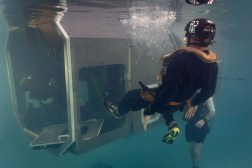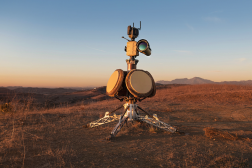Marines to get new Bolt kamikaze drones from Anduril

Anduril plans to deliver its newly revealed loitering munitions, dubbed Bolt-M, to the Marine Corps in the coming months for the Organic Precision Fires-Light (OPF-L) program.
The company on Thursday will be the last of three contractors tapped for the initiative to officially unveil their offering.
In April, the Defense Department announced that Anduril, AeroVironment and Teledyne FLIR won contracts to provide kamikaze drones for the program, as the Marines move to give dismounted troops enhanced strike capabilities under a modernization plan known as Force Design. The contracts included $8.9 million for AeroVironment, $12.1 million for Teledyne FLIR and $6.5 million for Anduril, but the deals could have a total combined value of up to $249 million, according to the Pentagon. Work is expected to be completed by April 2026.
AeroVironment announced in April that the next-generation Block 20 variant of its Switchblade 300 system had been selected for the program. In May, Teledyne FLIR introduced its new Rogue 1 platform, which the company said it was offering for the OPF-L effort. But Anduril kept its product under wraps until this week.
The Bolt is a vertical takeoff and landing (VTOL) drone that doesn’t require a runway. It’s also “man-packable,” according to Anduril, with a gross weight of about 15 pounds.
“There’s a sort of basic backpack form factor that that this packs down into, and you can throw it on your back and bring it with you. So in that respect, yeah, we really mean sort of the ability of a single operator to carry it, set it up, launch it, use it,” Chris Brose, the company’s chief strategy officer, told DefenseScoop during a call with reporters to discuss the system ahead of the official unveiling.
The company is touting the technology as an “autonomous” air vehicle, equipped with an AI software package called Lattice, that doesn’t require nearly as much operator training and engagement as some of the first-person-view drones that have been widely employed in places like Ukraine.
The system offers autonomous waypoint navigation, “target-agnostic object tracking, customizable standoff distances and engagement modalities,” according to the firm.
Troops can “launch a Bolt and send it out into a certain area, you know, kind of draw a bounding box on a map and basically put it in a loiter to do surveillance or to be on call in the event that another sensor detects a threat out in that environment,” Brose told DefenseScoop.
“The system has … the onboard intelligence to be able to discern basic, you know, kind of battlefield objects, people, vehicles, things of that sort. But then if there is something that’s unknown to the [AI and computer vision] system, you know, the ability to surface … what could be something that’s anomalous or something that’s not understood. Or just give the operator the ability to, you know, kind of extend their understanding of the battlespace and if there is something that’s unknown, to basically flag it, I mean, to put a bounding box around it and say, ‘Hey, I want you to kind of further surveil this’ or ‘I want you to stick with this to help me gather more information about what that might be,’” Brose said. “And if they make the decision that they want to do something about it, you know, they can also then direct the system to attack in different ways … Whether, you know, it’s a particular kind of angle of ingress or angle of attack, you know, whether it’s top down, you know, these are all things that the user can select … with like a click of the button, so to speak. And then the system does the rest and sort of takes that direction or intent and executes the command.”
Algorithms onboard the kamikaze drone can maintain terminal guidance and enable the weapon to hit its target even if connectivity with the human operator is lost during an attack, according to company officials, who also said the unmanned aerial system is compatible with a variety of warheads that can be swapped out.
The platform has more than 40 minutes of endurance, 20 kilometers of range, and can strike light vehicles, dismounted personnel, trenches or other targets, according to Anduril, with a munition payload capacity of up to 3 pounds. The company did not disclose other specifications such as its top speed.
Deliveries of Bolt to the Marine Corps are slated to take place over the next six months. Brose declined to disclose how many systems will be provided for the upcoming test-and-evaluation efforts, which are expected to inform government acquisition and fielding plans in fiscal 2025 and beyond.
“I believe they’re in a phase of evaluating, you know, a handful of capabilities, Bolt being one of them. And then, you know, a larger competition will flow from there,” he said.
Meanwhile, Anduril is eyeing another branch of the U.S. military as a potential future customer for the platform.
“The Army also has requirements for smaller loitering munitions, smaller … man-packable precision fires capabilities. So, you know, I think as the Army begins to figure out, you know, how it wants to structure programs, you know, kind of what acquisition strategies it wants to put in place, funding profiles, etc., … we’re excited to be able to bring Bolt to bear for them in that regard,” Brose said. “We think, you know, there’s a lot about the system that differentiates it in terms of its autonomy, in terms of its onboard artificial intelligence, … speed, warhead, you know things of that sort. So you know, really excited to be able to potentially do more with the Army in that respect.”






